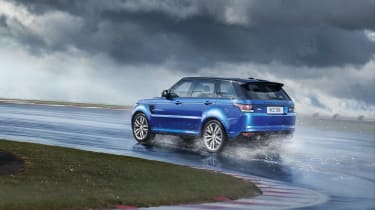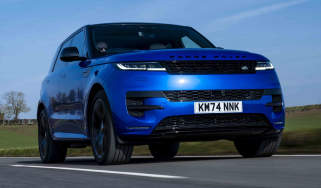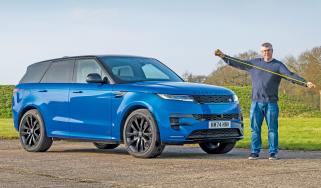Range Rover Sport SVR: video, pictures and details
Full details on Range Rover Sport SVR unveiled at Pebble Beach: on sale from October, prices start at £93,450
Land Rover has revealed full details on its fastest and most powerful production car ever, the 543bhp Range Rover Sport SVR. And the SVR has already become a surprise Nurburgring record holder, lapping the infamous Nordschleife in 8 minutes 14 seconds – the fastest time ever recorded for an SUV. That time puts it firmly in supercar territory, and only 10 seconds slower than an Audi R8 V8.
Land Rover’s new halo model is the latest vehicle to emerge from its new Special Vehicle Operations performance division, following the F-Type-based Project 7 - and will debut at this week’s Pebble Beach Concours d’Elegance in Monterey, California.
At the heart of the SVR is a tuned version of the 5.0-litre supercharged V8 from the standard Range Rover Sport, which drives all four wheels via an eight-speed automatic gearbox. Power now stands at 542bhp and 680Nm of torque, an increase of 40bhp and 56Nm respectively. The improvements mean the Range Rover Sport SVR trumps the 520bhp Porsche Cayenne Turbo for headline power outputs, but can only match the Porsche when it comes to the 0-60mph sprint - both cars completing it in a scorching 4.5 seconds. The Porsche pulls ahead at higher speeds though, topping out at 173mph, while the SVR can only manage an electronically-limited 162mph.

In order to extract maximum performance and drama, Land Rover has equipped the SVR with a two-stage active exhaust featuring electronically controlled valves, with quad pipes at the back. It provides a throatier soundtrack and a boost in performance at higher revs, while optional 22-inch alloy wheels wrapped in sticky Continental SportContact performance tyres offer improved traction. As standard, Land Rover will fit a 21-inch alloy with all-season rubber.
Shift times from the eight-speed gearbox have been cut by up to 50 per cent thanks fuel cut-offs during upshifts, and the rear locking differential locks up earlier to send power to the rear wheel with most traction. The ride height is unaltered, although modified pistons and dampers for the air suspension are said to significantly improve body control.
The visual tweaks are plain to see and not just cosmetic either: The deeper front bumper and larger air intakes are there to improve cooling, while round the back, there’s a more prominent rear bumper and new diffuser, both designed to boost aerodynamic efficiency. Bespoke sport seats differentiate the SVR from the standard Range Rover Sport inside, too.

Key to the new performance benchmarks set by the SVR is the all-aluminium monocoque borrowed from the latest Range Rover. The lightweight architecture helps cut weight by 39 per cent in comparison to the previous Range Rover Sport. Yet, even with the new performance flagship, Range Rover hasn’t lost sight of its ethos to provide high levels of refinement, luxury and off-road capability.
Although buyers of Land Rover’s fastest ever model are unlikely to venture off-road, permanent all-wheel drive and a low-range gearbox have both been fitted. A wading depth of up to 850mm and a towing capability of 3,000kg are also in reserve if customers ever require it, too.
The Range Rover Sport SVR will be sold and produced alongside standard Land Rover models, with customers able to place orders from October. Priced at £93,450 – £11,875 more than the regular Range Rover Sport – first deliveries are expected early 2015.
Find a car with the experts








